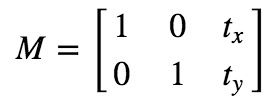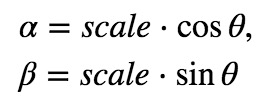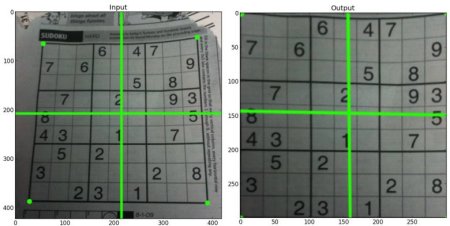目标
在本教程中:
- 你将会学到将不同的几何变换应用于图像,如平移、旋转、仿射变换等。
- 你会学到如下函数:cv.getPerspectiveTransform
变换
OpenCV 提供了两个转换函数,cv.warpAffine 和 cv.warpPerspective,可以进行各种转换。 cv.warpAffine 采用 2x3 变换矩阵,而 cv.warpPerspective 采用 3x3 变换矩阵作为输入。
缩放
缩放是调整图片的大小。 OpenCV 使用 cv.resize() 函数进行调整。可以手动指定图像的大小,也可以指定比例因子。可以使用不同的插值方法。对于下采样(图像上缩小),最合适的插值方法是 cv.INTER_AREA 对于上采样(放大),最好的方法是 cv.INTER_CUBIC (速度较慢)和 cv.INTER_LINEAR (速度较快)。默认情况下,所使用的插值方法都是 cv.INTER_AREA 。你可以使用如下方法调整输入图片大小:
import numpy as npimport cv2 as cvimg = cv.imread('messi5.jpg')res = cv.resize(img,None,fx=2, fy=2, interpolation = cv.INTER_CUBIC)#ORheight, width = img.shape[:2]res = cv.resize(img,(2*width, 2*height), interpolation = cv.INTER_CUBIC)
平移变换
平移变换是物体位置的移动。如果知道 (x,y) 方向的偏移量,假设为 (t_x,t_y),则可以创建如下转换矩阵 M:

您可以将变换矩阵存为 np.float32 类型的 numpy 数组,并将其作为 cv.warpAffine 的第二个参数。请参见以下转换(100,50)的示例:
import numpy as npimport cv2 as cvimg = cv.imread('messi5.jpg',0)rows,cols = img.shapeM = np.float32([[1,0,100],[0,1,50]])dst = cv.warpAffine(img,M,(cols,rows))cv.imshow('img',dst)cv.waitKey(0)cv.destroyAllWindows()
警告
cv.warpAffine 函数的第三个参数是输出图像的大小,其形式应为(宽度、高度)。记住宽度=列数,高度=行数。
结果:

旋转
以  角度旋转图片的转换矩阵形式为:
角度旋转图片的转换矩阵形式为:

但 Opencv 提供了可变旋转中心的比例变换,所以你可以在任意位置旋转图片,修改后的转换矩阵为:

其中:

为了找到这个转换矩阵,opencv 提供了一个函数, cv.getRotationMatrix2D 。请查看下面的示例,它将图像相对于中心旋转 90 度,而不进行任何缩放。
img = cv.imread('messi5.jpg',0)rows,cols = img.shape# cols-1 and rows-1 are the coordinate limits.M = cv.getRotationMatrix2D(((cols-1)/2.0,(rows-1)/2.0),90,1)dst = cv.warpAffine(img,M,(cols,rows))
结果:

仿射变换
在仿射变换中,原始图像中的所有平行线在输出图像中仍然是平行的。为了找到变换矩阵,我们需要从输入图像中取三个点及其在输出图像中的对应位置。然后 cv.getAffineTransform 将创建一个 2x3 矩阵,该矩阵将传递给 cv.warpAffine 。
查看下面的示例,并注意我选择的点(用绿色标记):
img = cv.imread('drawing.png')rows,cols,ch = img.shapepts1 = np.float32([[50,50],[200,50],[50,200]])pts2 = np.float32([[10,100],[200,50],[100,250]])M = cv.getAffineTransform(pts1,pts2)dst = cv.warpAffine(img,M,(cols,rows))plt.subplot(121),plt.imshow(img),plt.title('Input')plt.subplot(122),plt.imshow(dst),plt.title('Output')plt.show()
结果:

透视变换
对透视转换,你需要一个 3x3 变换矩阵。即使在转换之后,直线也将保持直线。要找到这个变换矩阵,需要输入图像上的 4 个点和输出图像上的相应点。在这四点中,任意三点不应该共线。然后通过 cv.getPerspectiveTransform 找到变换矩阵。然后对这个 3x3 变换矩阵使用 cv.warpPerspective。
请看代码:
img = cv.imread('sudoku.png')rows,cols,ch = img.shapepts1 = np.float32([[56,65],[368,52],[28,387],[389,390]])pts2 = np.float32([[0,0],[300,0],[0,300],[300,300]])M = cv.getPerspectiveTransform(pts1,pts2)dst = cv.warpPerspective(img,M,(300,300))plt.subplot(121),plt.imshow(img),plt.title('Input')plt.subplot(122),plt.imshow(dst),plt.title('Output')plt.show()
结果:

其他资源
1、”Computer Vision: Algorithms and Applications”, Richard Szelisk

